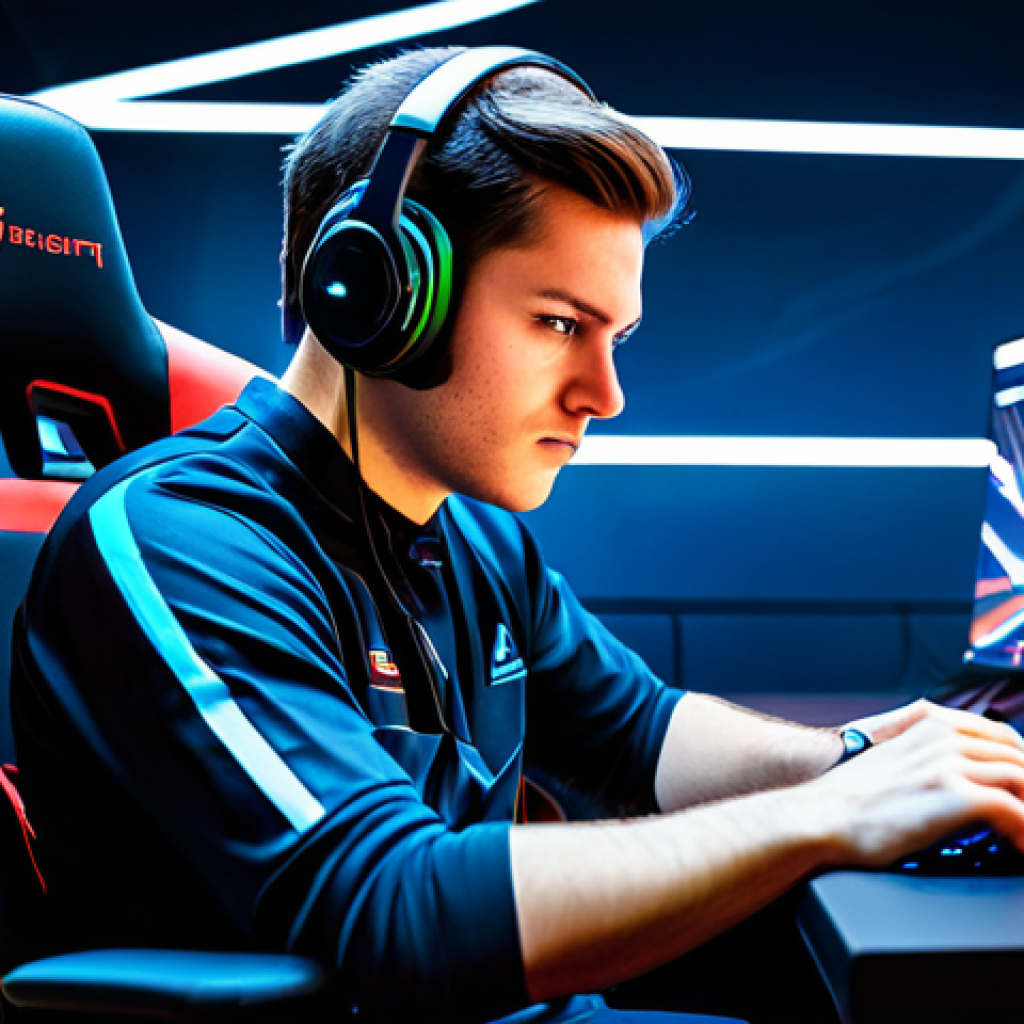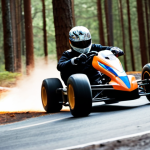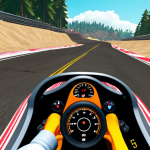You’ve mastered the basics, flawlessly executing those standard drifts, but there’s a nagging feeling, isn’t there? That moment when you realize you’re hitting a plateau in KartRider, stuck just shy of true competitive speed, is incredibly frustrating.
I’ve been there, pulling my hair out after countless laps, watching top players seemingly defy physics while I struggled to shave off those crucial milliseconds.
It’s not about just drifting *more* anymore; it’s about *how* and *where* you drift with unparalleled precision. From my own countless hours on the track, meticulously analyzing replays and enduring countless trial-and-error runs, I’ve discovered that truly leveling up involves a deeper understanding of momentum, precise line optimization, and chaining advanced techniques seamlessly.
This isn’t just theory; it’s the gritty reality of competitive KartRider: Drift, where every nuanced turn and perfectly timed boost can mean the difference between a podium finish and falling behind.
The current meta thrives on this kind of refined skill, emphasizing not just speed but supreme consistency and strategic execution. As the game continues to evolve and new competitive strategies emerge, mastering these intermediate speed techniques isn’t just an option; it’s absolutely essential to stay relevant and truly dominate the evolving tracks.
It’s about building a rock-solid foundation for future breakthroughs, preparing you for the most intense challenges the game throws your way. We’re talking about the art of the multi-drift, the elusive S-drift, and maintaining peak boost efficiency through complex corners – skills that elevate your gameplay from good to genuinely impressive.
Forget generic tips; we’re diving into actionable strategies, refined through actual play, designed to give you that unfair edge. Ready to finally break through that skill ceiling and see your lap times plummet?
Let’s pinpoint the exact methods.
The Art of the Seamless Multi-Drift: Beyond Simple Corners

When I first started seriously competing, I thought multi-drifting was just about holding the drift button longer or tapping it quickly. Boy, was I wrong!
It’s less about brute force and more about surgical precision and understanding your kart’s momentum. The truly game-changing moment for me came when I realized the multi-drift isn’t just one continuous slide, but a series of micro-adjustments and perfectly timed taps that allow you to chain boosts while maintaining an optimal racing line.
It’s an exhilarating feeling when you nail a perfect multi-drift through a long bend, watching your boost gauge climb as you smoothly navigate what used to be a messy, speed-killing turn.
It’s about feeling the flow of the track, anticipating the next segment, and making your input incredibly precise.
1. Mastering Drift Angle and Duration
The biggest mistake I see intermediate players make is either over-drifting or under-drifting. Over-drifting kills your speed and often leads to hitting walls or losing your line entirely.
Under-drifting means you’re not generating enough boost. The key is finding that sweet spot where your kart is drifting just enough to maintain momentum and generate boost, without losing too much speed to friction.
I remember countless hours in Time Attack, replaying my ghost, trying to shave off fractions of a second by slightly adjusting my drift angle. It’s often just a tap, tap, *hold slightly*, tap sequence, rather than one long, aggressive hold.
Think of it like feathering the throttle in a real race car—you’re constantly making tiny corrections. The goal is to exit the drift in a straight line, pointing exactly where you want to go next, with a full boost ready to fire.
This might sound obvious, but the nuance of *how* long you hold each tap or the main drift determines everything.
2. Chaining Boosts Effectively During Multi-Drifts
This is where the magic really happens. A multi-drift isn’t just about turning; it’s about continuously generating and *using* boosts. As you initiate your drift and release, you get a small boost.
The trick is to immediately re-initiate another small drift to get another boost, often before the first boost has even fully depleted. This creates a chain of speed that’s incredibly difficult for competitors to counter.
It requires an almost rhythmic understanding of the boost timing and the track layout. My personal breakthrough was on specific tracks like “Skyway” or “Desert Pyramid,” where long, sweeping turns allowed for extended multi-drifts.
I’d visualize the boost bar, seeing how quickly I could refill it and deploy a new boost, almost like a rapid-fire sequence. It’s an intoxicating sensation when you’re effortlessly gliding around a massive corner, leaving rivals in your dust while your speed stays consistently high.
It’s about being constantly in motion, constantly accelerating, minimizing any speed loss.
Deconstructing the Elusive S-Drift: Flow and Recovery
The S-Drift is often seen as this mythical, high-level technique, but honestly, it’s more about muscle memory and understanding weight transfer than any arcane secret.
When I finally “got” the S-Drift, it felt like unlocking a cheat code. It transformed my ability to navigate tight, winding sections of a track, converting what used to be momentum-killing turns into opportunities for continuous speed generation.
It’s not just for aesthetics; it’s a critical tool for maintaining peak velocity through successive, opposite-direction corners. Imagine turning left, then immediately right, but doing so with a fluid, unbroken motion that keeps your boost active and your speed climbing.
It’s exhilarating to pull off perfectly because it feels so counter-intuitive yet yields such powerful results.
1. The Setup: Initiating the S-Drift with Precision
An S-Drift isn’t something you just randomly throw out. It requires a precise setup. You typically initiate a drift in one direction (say, left) to begin the first curve of the “S.” The crucial part is recognizing the exact moment to *cancel* that drift and immediately *initiate* a drift in the opposite direction (right) to complete the “S” shape.
This transition needs to be incredibly smooth; any hesitation or overcorrection will break your momentum. I found practicing this in isolation, just doing repetitive S-drifts on a straight section of track, incredibly helpful.
It’s about building that intuitive feel for when to release and flick the stick the other way. For me, it was less about visual cues and more about the *feel* of the kart’s angle and speed.
It’s like a dancer’s pivot – precise, powerful, and seamless.
2. Recovering and Maximizing Exit Speed
The S-Drift isn’t complete until you’ve successfully exited it with maximum speed. Often, players focus so much on the “S” motion itself that they forget about the recovery.
After the second drift in the “S” is complete, you want to be perfectly aligned with the next straightaway or turn, having generated a full boost. This means understanding when to release the final drift and how to angle your kart to minimize any corrective steering.
A common pitfall is exiting too wide or too narrow, which forces you to adjust and lose precious milliseconds. The goal is to come out of the “S” like an arrow shot from a bow – straight, fast, and aimed perfectly at your next target.
This often involves a tiny counter-steer at the very end of the second drift, just enough to straighten out your line without losing the boost.
Optimizing Boost Management: The Heartbeat of Sustained Speed
Everyone knows boosts make you go fast, but truly *optimizing* your boost usage is what separates the pack from the pros. It’s not about just firing off every boost the moment you get it; it’s about strategic deployment and ensuring you’re generating boosts consistently.
My own “aha!” moment came during a particularly brutal ranked match where I was out-boosted by an opponent who seemed to have an endless supply. I reviewed the replay and realized they weren’t just *faster* but *smarter* with their boost economy.
They were always boosting, but never wasting, always accumulating, and always ready. This isn’t just about pressing a button; it’s about understanding the rhythm of the track and the ebb and flow of your boost meter.
1. Strategic Boost Deployment: When and Why
This is probably the most critical aspect of boost management. You need to consider *when* to use your boosts. Do you use it immediately after a drift?
Do you save it for a long straight? Do you chain it with an item? My experience taught me to prioritize boosts on long straights to maximize top speed, and crucially, to use them to maintain momentum through tricky sections where speed might otherwise drop.
For instance, using a boost *into* a corner, then immediately initiating a drift to collect another boost as you exit, creates a powerful speed burst.
Avoiding using boosts into walls or into sections where you’ll immediately have to brake is common sense, but under pressure, it’s easy to make those mistakes.
Always ask yourself: “Will this boost get me significantly ahead, or can I save it for a more impactful moment?”
2. The Art of the Infinite Boost Chain (or Near-Infinite)
While “infinite boost” isn’t strictly possible in KartRider: Drift without specific items, the concept of a near-infinite chain is absolutely achievable through masterful drifting.
This means consistently generating boost immediately after using one. It’s a continuous cycle: drift, get boost, use boost, immediately drift again, get boost, use boost.
This requires incredible consistency in your drift execution. If your drifts are messy, or you’re not generating enough boost per drift, your chain will break.
I found practicing the “boost-drift-boost” sequence on open sections of the track, focusing purely on the rhythm, was revolutionary. It’s like playing a musical instrument – the timing has to be perfect.
The payoff is immense: a consistent speed advantage that simply grinds down your opponents over the course of a race.
Cornering Precision: Angles, Lines, and the Unseen Path
You might think corners are just about turning, but for competitive players, they’re where races are won and lost. A perfectly executed corner can shave seconds off your lap time and give you an insurmountable lead.
I used to just follow the “driving line” suggested by the game, but that’s a basic concept. True cornering precision is about finding the optimal *racing line* that minimizes distance while maximizing speed and boost generation.
It’s about seeing the track differently, identifying the hidden shortcuts and perfect angles that aren’t immediately obvious. It’s a blend of intuition and rigorous practice, constantly pushing the boundaries of what’s possible around each bend.
1. Identifying the Optimal Racing Line: Apex and Exit
The classic racing line involves approaching a corner wide, cutting into the apex (the innermost point of the turn), and then exiting wide. This principle holds true in KartRider: Drift, but with the added layer of drift mechanics.
The goal is to hit the apex *while* your kart is mid-drift, allowing you to maximize boost generation and straighten out for a clean exit. The exit is just as important as the entry; you want to be pointing straight down the next section of the track with maximum momentum.
I often found myself replaying races, pausing at each corner, and asking, “Could I have entered wider? Could I have hit the apex tighter? Could my exit have been cleaner?” It’s a relentless pursuit of perfection, where every degree of angle matters.
2. Mastering Corner Entry and Exit Speeds
Your speed *entering* a corner dictates how well you can drift and generate boost. Entering too fast will lead to over-drifting or hitting a wall. Entering too slow means you’re giving up time.
The art is finding the maximum speed at which you can still execute a clean, boost-generating drift. Similarly, your exit speed is paramount. You want to carry as much speed as possible out of the corner and into the next segment.
This often means sacrificing a tiny bit of entry speed to ensure a faster, boost-fueled exit. It’s a delicate balance. I’ve personally seen my lap times drop dramatically just by focusing on smoother, faster exits, even if it meant a slightly more cautious entry.
It’s about momentum conservation above all else.
The Mind Game: Track Awareness and Anticipation
Beyond the mechanics, truly advanced play involves a significant mental component. It’s about more than just reacting to what’s happening; it’s about anticipating, planning, and adapting on the fly.
When I moved from being an “intermediate” player to a “competitive” one, it wasn’t just my drifting that improved; it was my ability to *read* the race and *predict* what my opponents would do.
This heightened awareness allows you to make split-second decisions that can turn the tide of a race, whether it’s avoiding a chaotic pile-up or setting up the perfect overtake.
It’s about being two steps ahead, always.
1. Reading the Track: Hazards and Opportunities
A truly skilled KartRider player doesn’t just see the track; they *read* it. They understand where the rough patches are, where the ideal boost pads are located, and where opponents are likely to clump up.
This proactive awareness allows you to avoid pitfalls before they happen. For example, knowing that a particular narrow section often turns into a bottleneck means you can adjust your line early to avoid being trapped, or even use it to your advantage by setting up a tactical drift or item use.
I still mentally map out every track before a race, highlighting high-traffic zones, potential shortcut opportunities, and areas where I know I can consistently pull off a perfect drift.
It’s like having an internal GPS for speed.
2. Opponent Anticipation and Adaptive Racing
This is where the “mind game” truly comes into play. It’s not just you and the track; it’s you, the track, and up to seven other unpredictable racers.
Anticipating their moves – when they’ll use an item, when they’ll attempt an overtake, where they might crash – is crucial. If you see someone with a potent item like a Magnet or a Missile, you can adjust your line or save a shield.
If you notice a particular opponent always takes a wide line on a certain corner, you can plan an inside overtake. This adaptive play is born from experience and countless hours observing other drivers.
I remember a specific race where I anticipated a rival’s last-second overtake attempt, adjusted my line mid-drift, and forced them into a wall, securing my win.
It felt like playing chess at 100 mph.
| Technique | Description | Primary Benefit | Practice Tip |
|---|---|---|---|
| Multi-Drift Precision | Series of small, controlled drifts for sustained boost and speed through long curves. | Consistent High Speed, Boost Generation | Focus on short, rhythmic taps, not long holds. Time Attack on “Skyway”. |
| S-Drift Mastery | Seamlessly transitioning drifts in opposite directions through S-shaped turns. | Momentum Retention, Efficient Cornering | Practice the precise flick/release on a straight section repeatedly until fluid. |
| Strategic Boost Use | Deploying boosts not just when available, but when most impactful (straights, specific corners). | Maximized Top Speed, Sustained Pace | Analyze replays: Where did you gain/lose speed with boost? Experiment with timing. |
| Optimal Racing Lines | Finding the shortest, fastest path through corners, hitting apexes and clean exits. | Reduced Lap Times, Smoother Racing | Watch top players’ ghost data in Time Attack; try to replicate their lines exactly. |
Gear, Setup, and Practice: Refining Your Competitive Edge
While raw skill is paramount, dismissing the importance of your kart setup and consistent practice would be a huge disservice. When I started climbing the ranks, I realized that even small tweaks to my kart’s stats or a more structured practice routine made a measurable difference.
It’s like a professional athlete optimizing their equipment and training regimen; every little bit counts. You wouldn’t expect a golfer to use a mismatched set of clubs and still compete at the highest level, right?
The same applies here. Your kart is an extension of you, and fine-tuning it to your playstyle, coupled with deliberate practice, can genuinely unlock your next level of performance.
1. Understanding Kart Stats and Customization
KartRider: Drift offers a surprising depth in kart customization, not just aesthetically, but in performance. Different karts have varying stats in speed, acceleration, drift, boost, and handling.
What works for one player might not work for another. I spent a significant amount of time experimenting with different karts and parts, trying to find the setup that best complemented my aggressive, boost-heavy playstyle.
For instance, if you’re struggling with control, a kart with higher handling might be beneficial, even if it sacrifices a tiny bit of top speed. My advice is to not just pick the “fastest” kart, but the one that feels most responsive and controllable for *you*.
Sometimes, a small sacrifice in raw speed for better control means you’ll hit more perfect drifts and maintain higher average speeds. It’s about synergy between kart and driver.
2. The Power of Deliberate Practice and Replay Analysis
You can watch all the guides in the world, but nothing beats focused, deliberate practice. My practice routine evolved significantly from just “playing” to “training.” I started setting specific goals for each practice session: “Today, I will perfect the S-Drift on this one corner,” or “I will consistently hit perfect multi-drifts on this straight.” Time Attack mode became my best friend.
The most transformative habit I developed was watching my own replays, especially when I knew I made a mistake. I’d slow them down, analyze my inputs, and compare my line to top players’ ghosts.
It’s humbling to see how much room for improvement there always is, but also incredibly motivating. This analytical approach, breaking down my own gameplay, was arguably the single biggest factor in my improvement.
It’s like being your own coach, constantly pushing for refinement.
Wrapping It Up
Reaching that next level in KartRider: Drift isn’t just about raw talent; it’s a journey of continuous learning, meticulous practice, and a deep understanding of the game’s intricate mechanics. My personal growth, from a frustrated intermediate to a confident competitor, truly hinged on embracing these advanced techniques and, more importantly, adopting a mindset of constant self-improvement. It’s an incredibly rewarding feeling when the track feels like an extension of your will, and every drift, boost, and turn flows seamlessly into the next. Keep pushing, keep practicing, and you’ll undoubtedly feel that exhilarating thrill of mastery too.
Handy Tips to Remember
1. Listen to the Engine: Pay attention to the subtle sound cues your kart makes. A higher pitched engine sound often indicates you’re reaching optimal speed for a boost or holding a drift effectively, while a lower rumble might suggest speed loss or an inefficient drift.
2. Master the Mini-Map: The mini-map isn’t just for showing where opponents are; it’s a vital tool for anticipating upcoming turns, identifying potential shortcuts, and even spotting items your rivals might be holding. Train your eyes to glance at it constantly.
3. Warm-Up Your Hands: Before jumping into competitive races, spend 5-10 minutes in Time Attack or a custom single race to get your fingers and mind warmed up. This helps with muscle memory and reduces early race errors due to cold hands.
4. Find Your Sensitivity Sweet Spot: Experiment with controller or keyboard sensitivity settings. What works for a pro might not work for you initially. Adjust until turning and drifting feel natural and precise, allowing for micro-adjustments.
5. Analyze Pro Replays Beyond Your Own: While analyzing your own replays is crucial, also dedicate time to watching top-tier players’ ghost data or streaming content. Observe their lines, their boost timings, and how they handle pressure. There’s always something new to learn.
Key Takeaways
To truly excel in KartRider: Drift, focus on refining your Multi-Drift and S-Drift precision for consistent boost generation. Strategically manage your boosts, prioritizing impact over immediate deployment. Master optimal racing lines by understanding apexes and exits for superior cornering. Develop strong track awareness and anticipate opponent moves to gain a crucial mental edge. Finally, fine-tune your kart setup and engage in deliberate, analytical practice, utilizing replay analysis to relentlessly improve your technique.
Frequently Asked Questions (FAQ) 📖
Q: I’ve hit that frustrating plateau you mentioned – I’ve got the basics down, but I’m still not competing at the top level. What’s the biggest mindset shift or a fundamental new approach I need to adopt to truly break through this barrier in KartRider: Drift?
A: Oh, I know that feeling all too well – it’s like running into an invisible wall, isn’t it? For me, the massive shift wasn’t about more drifting, but about smarter drifting.
Initially, I just focused on hitting every drift possible, but I quickly realized the pros weren’t just drifting; they were sculpting their lines with surgical precision.
It’s less about just performing a drift and more about understanding the flow of momentum through a corner. My own breakthrough happened when I started obsessively analyzing replays, not just of myself, but of the top players.
I’d watch their ghost data frame by frame and think, “Why did they start their drift there? Why did they release then?” It wasn’t always the most obvious line.
It was often about setting up the next turn, maintaining an invisible flow of speed, or squeezing every last bit of boost out of a section. You’re shifting from reactive drifting to proactive, strategic track domination.
It’s about viewing the track as a series of interconnected energy transfers, not just individual corners. That’s where the magic really starts to happen.
Q: You mentioned advanced techniques like the multi-drift, S-drift, and maintaining peak boost efficiency. How do these specific skills truly elevate gameplay, and what’s the most effective way to start incorporating them if I’m struggling to get them down?
A: These techniques aren’t just flashy; they’re the bedrock of competitive speed, trust me. The multi-drift, for example, isn’t just about gaining more boost – it’s about controlling your trajectory through wide, sweeping corners where a single drift would scrub too much speed.
I remember finally nailing a perfectly chained multi-drift on something like “Ice Crash Track,” and suddenly, I was carrying so much more momentum into the straightaway; it felt like I’d just unlocked a secret gear.
It’s about keeping your speed up while still generating boost, a delicate dance of control and aggression. As for the S-drift, that’s your secret weapon for quickly changing direction while maintaining boost, especially on those tight, alternating turns.
It feels awkward at first, like trying to write with your non-dominant hand, but once it clicks, it’s invaluable. My advice? Don’t try to master everything at once.
Pick one technique, like the basic multi-drift, and dedicate twenty minutes of pure grind time in Time Attack on a simple track. Forget lap times, just focus on the muscle memory.
My real breakthrough came when I stopped trying to be perfect and just focused on consistency in execution. It’s messy at first, but that raw repetition is what hardwires it into your brain.
Q: The current meta seems to prioritize “supreme consistency and strategic execution” over raw speed. How do I practically build that kind of rock-solid consistency and truly integrate strategic thinking into my actual races, especially under pressure?
A: This is the million-dollar question, isn’t it? Pure speed is useless if you’re hitting walls every other lap. Consistency, especially under pressure, comes from a deep, almost instinctual understanding of the track and your kart.
For me, it was less about memorizing lines and more about internalizing the feeling of a perfect corner entry and exit. I’d spend hours in custom lobbies with friends, not just racing, but openly discussing lines, trying different approaches, and even intentionally trying to mess up to understand the limits.
The “strategic execution” part kicks in when you stop reacting to the track and start anticipating it. Think two, three corners ahead. If I take this line here, what does it open up for me on the next straight?
Am I setting myself up for a critical boost or an awkward recovery? My lightbulb moment was on “Factory Circuit,” where taking a slightly wider entry on one turn allowed me to hit a perfect S-drift on the following tight chicane, giving me a huge advantage.
It’s about seeing the sequence, not just individual moments. And when the pressure hits, it’s that ingrained consistency from thousands of repetitions that kicks in, not frantic panic.
You just do it.
📚 References
Wikipedia Encyclopedia
구글 검색 결과
구글 검색 결과
구글 검색 결과
구글 검색 결과
구글 검색 결과






